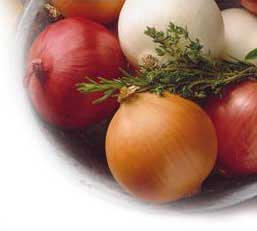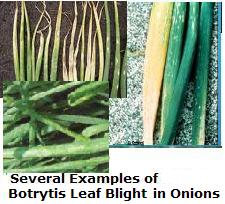How to Grow Onions
Growing Onions - Online Fact Sheet
 |
|
|
|
|
|
|
|
Planting Onions
When planting onions choose a garden site that is in full sun and has a well-drained soil.
A soil pH of 6.0 to 6.5 is ideal for growing onions. Apply lime and fertilize according to soil test
results.
Many gardeners plant onions in a raised bed, rich in well-rotted
Compost,
manure, and other organic matter. Manure that contains straw or
wood shavings may cause a temporary lack of nitrogen in the soil. The
bacteria breaking down organic waste utilizes nitrogen and takes it from the
soil. The plants may suffer from this, so add nitrogen fertilizer when
digging such manure into the soil.
Onions can be grown from seeds, small dormant onions called "sets," or
onion transplants.
Onion Seeds should be sown in the garden in the midfall.
Onion Seedlings however, are
easier to grow in a soilless mix under controlled conditions. Sow onion seeds
about 1/4 inch deep, covering lightly with a soilless mixture. Most
onion seed
varieties should germinate in approximately 2 weeks. Grow onions in individual
peat pots or cell packs to
reduce transplant shock, several plants per cell or pack are advisable..
Onion Seedlings should be grown in a relatively cool location with full
sun for optimal results.
Transfer onion transplants into the garden when they reach pencil size
in diameter (about 1/4 inch). Set onion plants 1 inch deep, and about 3 to 4
inches apart, After the danger of frost is gone.
Cultivation of Onions
When growing onions keep in mind that they are are shallow rooted and any cultivation should be done carefully to avoid damage to the bulbs or roots. Cultivation should be shallow, without bringing excessive soil to the plants. Many gardeners pull the soil away from plants in order to allow greater bulb expansion. However, this practice is not needed on well prepared, highly organic soil. Mulching can also help control weeds.
Growing Onions in well-drained soils will discourage disease
problems. It is always wise to follow a rotation schedule
when planting onions.
Watering Onions
Watering is critical when growing onions. Water
slowly and deeply to produce healthy onions. Onions should
receive about an inch of water per week slightly more in
sandy soils. Inexpensive
watering timer systems are
available .
- Excessive watering could easily lead to rot and fungus particularly if your onions are not planted in a sunny area.
Fertilizing Onion Plants
Apply a complete fertilizer such as 8-8-8 or 10-10-10, a few
days prior to planting. Onions are heavy nitrogen feeders
early when producing roots and top growth. Side dress
approximately 5 or 6 weeks after planting with high non
sulfur nitrogen fertilizer, Side dress onions again in late
winter. Excessive applications of nitrogen can delay maturity
of bulbs, cause thick necks and splitting.
Weed Control
When
growing onions keep in mind
that they are are the least suited to compete with
weeds. Weed pressure can be especially damaging to young
onion plants because they are slow growing, have shallow
roots and do not have enough foliage to adequately shade the
ground. Herbicides are not recommended , as many attack the
crop as well... careful/ shallow cultivation and weeding is
essential .
Good Neighbors of Onions are Beets, Cabbage, Carrots, Celery, Cucumber, Lettuce, Pepper, Squash, Strawberries, and Tomato . Bad Neighbors include Bush Beans, Pole Beans, Peas.
Do not plant onions or other members of the Amaryllidaceae family in the same soil for more than one season.. Rotate the crops to various sections of your garden space from season to season.Planting
Chamomile with onions. Improves growth and flavor
See
Companion Planting for more extensive information
|
Bulb-forming onions produce a single bulb in a season. Bulb-forming onions include storage onions and fresh onions. The primary difference between storage and fresh onions is that storage onions keep for a longer period of time. Storage onions generally have a darker color, thicker skins, and a more pungent flavor than fresh onions. Storage onions can be grown from seed, onion sets, or transplants Perennial onions, produce clusters of small onions. Perennial onions include potato onions, bunching onions, Egyptian onions, and shallots. Fresh onions don't keep well and are best eaten soon after they are harvested. They are commonly referred to as sweet onions. For growers purposes Onions can be further divided into Short, Medium and Long day varieties
|
|
Short Day
Varieties
Yellow Granex
|
|
Medium
Day Varieties
Organic Falltime Leek 340 Seeds |
|
Long Day Varieties
Leeks
|
For Marketing & Culinary purposes theses categories
can be further subdivided into the following
WHITE ONIONS: Glossy white
appearance. One of the more pungent onions. Use raw on
burgers, sandwiches, salsa and similar dishes if you like
warm, but real tasty onions. Otherwise, they can be used in
any recipe that calls for cooked onions.
YELLOW ONIONS: Golden color with relatively strong flavor.
May be used cooked or raw, depending on your taste for a
somewhat pungent onion. Long, slow sautéing at very low heat
brings out sweet, mellow flavors.
RED ONIONS: Purplish rather than red, they are relatively
mild. Appealing in salads or sautéed in stir fries. Also
good for many other recipes. Adding a bit of vinegar, wine
or lemon juice helps keep color from fading or turning
purplish-blue. You'll often find red onions in salads at
restaurants.
SHALLOT: This is not a true onion, it is a small relative of
the onion with dry, coppery skin. The flavor combines onions
and garlic. Hot when raw, but cooks to a delicate flavor.
SCALLIONS: This is a variety of onions that is harvested
before the bulb has formed. Mild flavor. Green onions have
tiny white bulbs at the bottom while scallions are younger
and have straight white sides at the root end.
LEEKS: In the scallion family. It looks like a large, fat
scallion with a white root and dark green, overlapping
leaves. Only the root is used. Careful trimming and cleaning
are necessary because dirt can accumulate in leaves.
Common pests of most Onion crops are
Root Maggots and Onion Maggots attack germinating seedlings, they feed on the developing roots and epicotyl. as well as the expanding bulb during later stages of plant development. [Image]
Beet armyworm and
Cutworms. Most damage can be avoided by using hardy
transplants.Onion plants can also be protected with
Bacillus thuringiensis
or spinosad sprays
.
Snails and Slugs Slugs and snails like to feed on young seedlings and succulent parts of plants. They leave a trail of mucus on the surfaces on which they crawl. Moist, humid environments favor slug development, and slugs usually overwinter in sheltered locations outdoors
Leafhoppers and leaf miners are also minor pests of Onion Plantings.
Aphids
are Yellowish-pink to pale green plant lice that suck ......plant
juices. They are a soft-bodied, oval/pear shaped insect and are commonly
found on nearly all varieties of plants, vegetables, field crops, and
fruit trees. [Images]
Hot Pepper Wax
repels bugs from your plants, fruits and flowers. 100% natural spray
uses pepper extract and wax to effectively discourage pests. Helps to
reduce stress on cuttings.
Most onions are also susceptible to fungal infestations, at times it can be a severe problem , particularly under moist conditions.
 |
|
 |
|
Downy Mildew [
Image] See:
Cornell Veg. MD online
University of Calif. Onion and Garlic
Downy Mildew
Pink Root Infected roots first turn light pink, then darken through red and purple, shrivel, turn black, and die. The pinkish red discoloration may extend up into the scales of the bulb. New roots also may become infected. If infection continues, plants become stunted. The disease seldom results in plant death. Infection is confined to roots and outer scales of the bulb. Severe infection will reduce bulb size.
Purple Blotch usually infects
dead or dying leaf tissue. The initial symptoms are small,
pale, sunken lesions. These lesions develop purple centers .
The infection can encompass much of the leaf, leading to the
death of tissue above the lesion. This disease can be
controlled with fungicides.
Black Mold occurs sporadically but is potentially serious. It causes damage primarily to stored onions, rendering them unpalatable and unmarketable.
References -
Identification of Diseases and Disorders of Onions
Colorado State Univ. Botrytis, Downy Mildew and Purple
Blotch of Onion
Harvesting and Storage of Onions
Onions will store better if they are dried for several days outdoors, away from direct sunlight.
- Leave the tops on the bulbs during drying.
- After drying, cut tops within an inch of bulb.
- Fresh sweet onions can be stored for several weeks in a cool, dark place. They can be stored in the refrigerator, but do not put them in plastic bags. This will inhibit air circulation.
- Storage onions should be dried for a longer period of 10 to 14 days. After cured, the tops can be removed and onions stored in mesh bags, or dried tops can be braided into a string of onions.
Canning onions
- It's best to use onions with a 1-inch diameter or less.
- Wash and peel onions.
- Cover with boiling water.
- Bring to a boil for 5 minutes.
- Pack the onions into hot jars, leaving an inch of headspace.
- Add ½ teaspoon salt to pints, 1 teaspoon to quarts
- Remove air bubbles. Wipe jar rims. Adjust lids and process both pints and quarts at 10 pounds pressure for 40 minutes.
Freezing Onions
- Bulb onions - store well in a cool, dry place. Freezing is not recommended.
- Choose mature bulbs , Clean thoroughly.
- Water blanch for 3 to 7 minutes or until center is heated.
- Cool promptly, drain and package, leaving a half inch
headspace. Seal securely, Then freeze.
These will be suitable for cooking not eating as is. - Green onions may be chopped and frozen without blanching,
See also Pickling and Onion Recipes
References
Plant Talk - Growing Onions from Seed